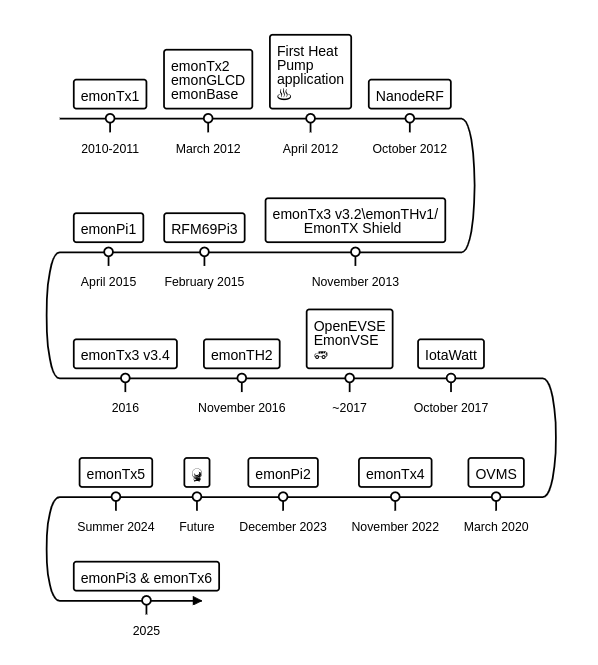I’ve been around a bit longer than you.
From the earliest records that I have a note of, it started with the emonTx V1 in around 2010-2011, the schematic and pcb drawings are undated, so I can’t be definitive. I first got involved in December 2011 when I emailed Trystan enquiring about the Efergy energy monitor, and I’d found OEM because this was a c.t. being used at the time. Trystan suggested I joined the community - though I suspect he regrets it from time to time 
An early contribution was a measurement of the ratio of the YHDC SCT-013-000 current transformer: believe it or not, no-one knew the true ratio, one supplier was advertising it with a completely wrong value.
The first emonTx I built was a V2, in the late summer of 2012. This had 3 c.t. inputs, one voltage, a temperature and a pulse input, and was a through-hole DIY kit. It used the Nanode RF as the base with an Ethernet connection into your LAN to emoncms.org (only!), but you could also have the emonGLCD if you wanted a local live display.
In April 2013, the emonTx V3.2 was introduced. Importantly, this too came ready-assembled and used the short-lived RFµ328 combined Atmel 328 / RFM 12B module. It had 4 current channels and one voltage.
The emonTx Shield appeared in November 2013 - essentially a 4-channel analogue conditioning module (with the radio) to plug into an Arduino Uno. This was again a DIY kit for self-assembly.
I think the emonTH V1.4 appeared in April 2014, also using the RFµ328 combined Atmel 328 / RFM 12B module. This too came ready-assembled.
It was superseded by the current emonTH V2 in July 2015 with the Atmel 328P directly on the pcb, and with either the RFM12B or RFM69CW.
Soon after, in August 2015, the emonPi V1.5 made an appearance, essentially a 2-channel emonTx mounted atop a Raspberry Pi in an aluminium case and with a LCD display.
This was superseded in May 2019 by the V1.6
Meanwhile the emonTx V3.4 appeared in January 2015, having the Atmel 328P directly on the pcb and using the RFM69CW radio.
Unfortunately, I can’t put a date to the RFM2Pi - this is a RFM12B radio module and processor plugging directly onto a Raspberry PI, but having no energy monitoring capability – essentially performing the same job as the Nanode RF with the added capabilities of the RPi. It was superseded by the RFM69Pi in May 2021.
The emonTx4.0.1 details appeared in March 2022, using the Atmel -DB processor.

